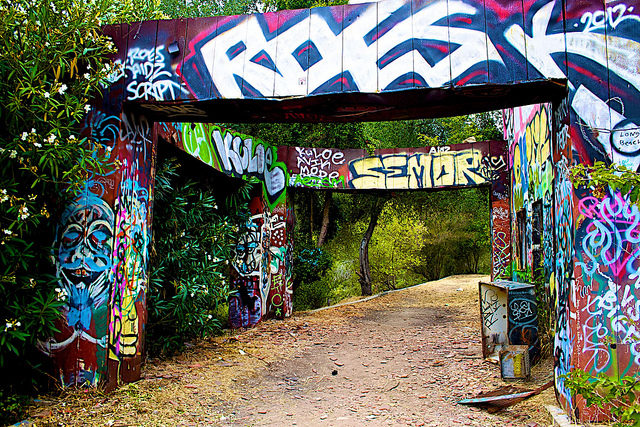Murphy Ranch in Rustic Canyon, Los Angeles was built in the 1930s as a self-sufficient compound. Since being abandoned in the 1990s, the complex has been visited by many historians, writers, and artists as a result of its mysterious history. It was designed by Winona and Norman Stephens, sympathizers of white-supremacist organization the Silver Legion of America.
Another person known to have been involved in its development was a man known only as Herr Schmidt, who first had the idea of the compound as a long-term, self-sufficient community. He convinced the Stephens that Germany would soon defeat the United States and that the end of the world was near. The official owner of the facility was Jessie M. Murphy who bought the land in 1933.
However, there is no record of such a person ever existing, and Jessie M. Murphy was likely the Stephens’ pseudonym. The complex seems to have been designed as a base for Nazi activities in the U. S. a decade before WWII. Those who have explored and studied the ruins since their abandonment have developed various theories about what happened there. The fully-equipped compound had everything that was necessary for a site to function on his own in many years of isolation outside society.

It had a fuel tank, a bomb shelter, a water storage tank, raised gardens, a power station, a hillside for growing food, and many bunkers and outbuildings. The main gate of the property was designed by the American architect Paul Williams.

Also, many cement stairs were built up the hill for patrolling the area and farming. Over $4 million was invested in this isolated community for its completion. Schmidt’s followers developed various plans for their new home and begun to hire architects who could create mansions and other structures on the property.

According to Curbed, Los Angeles, the designers had certain standard features such as the building of a four-storey mansion that would have a basement used for recreation, an indoor pool, a main “public floor” made in the middle of a grand central hall with multiple libraries, bedrooms, and social rooms.

The upper floors were designed to have private rooms and bedroom suites. Whatever the expectations of the group for the future were, they certainly decided to live in a luxurious style. The day after the Japanese attack on Pearl Harbor, the compound was taken over by the local police who arrested fifty guards around the ranch. It is said that on that day, Schmidt was arrested and the Murphy Ranch community was no more.

The four-story mansion was never built. The Stevenses were likely living above a steel garage on the property instead. After it was completely abandoned, the complex fell into a state of disrepair, and most of the structures are covered in colorful graffiti which draws the attention of many visitors. It is currently owned by the city of Los Angeles.

For safety reasons, in 2016, many of the buildings were demolished and the few that remain today are the power house and the buildings that in the past contained the diesel generators. Before it was completely abandoned, the complex was a place where some locals performed military drills during gatherings. Today, everyone can visit the camp, look at the abandoned buildings, wonder about their mysterious past, and admire the skills of the graffiti artists.

When the city bought the property in 1972, the compound was used as an artists’ colony but it was abandoned entirely in the 1990s because of a fire. No fee is required to visit this lost community from Sullivan Ridge Fire Road. The compound remains one of the most visited and fascinating places in Los Angeles for people who are interested in ruins and remnants of history.
